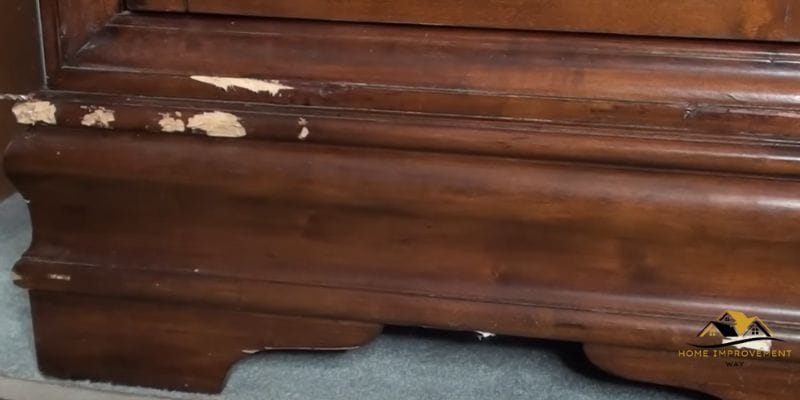How to Fix Chipped Wood: Easy Solutions for Restoring Damaged Furniture
To fix chipped wood, start by cleaning the area and removing any loose pieces. Then, apply a wood filler or putty to fill in the chip and allow it to dry.
Finally, sand the area smooth and apply a finish to match the surrounding wood. Wood furniture or surfaces can easily get chipped or damaged over time, detracting from their appearance and overall quality. Whether it’s a scratch, gouge, or an actual chip, repairing the damage promptly is essential to maintaining the beauty and durability of the wood.
Fortunately, fixing chipped wood is a relatively simple process that can be done with a few basic tools and materials. We will explore the step-by-step instructions on how to fix chipped wood, allowing you to restore the integrity and aesthetics of your wooden items. So, let’s dive in and learn the effective techniques to easily repair chipped wood.
Understanding The Damage
Fixing chipped wood is essential for maintaining the beauty of your furniture or flooring. Discover effective solutions and learn how to repair damaged wood with simple techniques.
The Main Heading:
In this section, we will delve into understanding the damage caused by chipped wood and how to effectively fix it. Identifying the type of wood damage and assessing the severity of the chip are crucial steps in the repair process. Let’s take a closer look at each of these aspects:

Identifying The Types Of Wood Damage:
Wood can suffer from various types of damage, each requiring a specific solution. Here are the common types of wood damage you may encounter:
- Chipped Edge: This occurs when a small piece of the wood’s edge has broken off, leaving a noticeable gap. It is often a result of impact or poor maintenance.
- Surface Scratch: These are shallow marks on the wood’s surface caused by sharp objects or friction. They may affect the aesthetics of the wood but are relatively easy to fix.
- Deep Gouge: A deep gouge is a more severe form of damage where a significant portion of the wood has been removed, leaving a noticeable groove or depression. These require more extensive repairs.
Assessing The Severity Of The Chip:
Once you have identified the type of wood damage, it’s essential to assess the severity of the chip. This will help determine the best course of action for repairing it. Here are some factors to consider when assessing the severity:
- Size of the Chip: Measure the dimensions of the chip, including length, width, and depth. This information will guide you in selecting the appropriate repair materials.
- Location of the Chip: Where the chip is located on the wood surface can affect both the visibility of the damage and the difficulty of the repair.
- Structural Integrity: Assess whether the chip compromises the structural integrity of the wood. If it weakens the overall stability of the piece, immediate action should be taken.
By understanding the type and severity of the chip, you will be better equipped to choose the right repair method and materials. With this knowledge in hand, let’s move on to the next step in fixing your chipped wood.
Diy Solutions For Fixing Chipped Wood
Chipped wood can be a real eyesore, tarnishing the appearance of your furniture or other wooden belongings. Fortunately, several DIY solutions can help you tackle this issue without breaking the bank. In this article, we’ll explore three effective methods for fixing chipped wood: using wood filler, reattaching splintered or detached pieces, and replacing the damaged section with new wood. Let’s dive in!
Using Wood Filler To Repair Small Chips
If you’re dealing with small chips in your wood, using a wood filler is a simple and cost-effective solution. Here’s how you can get the job done:
- Start by cleaning the damaged area to ensure there’s no dirt or debris.
- Using a putty knife, apply the wood filler to the chip, filling it in until it’s level with the surrounding surface.
- Allow the filler to dry completely, following the manufacturer’s instructions.
- Once dry, sand the area with fine-grit sandpaper until it’s smooth and flush with the rest of the wood.
- Finally, finish off the repair by applying a matching stain or paint to blend the spot with the rest of the surface.
Reattaching Splintered Or Detached Pieces
Sometimes, a chip in your wood might result in splintered or completely detached pieces. In such cases, you’ll need to reattach them securely. Follow these steps to effectively reattach splintered or detached wood pieces:
- Gather all the loose pieces and assess the damage to determine the best course of action.
- Apply wood glue to both the chipped area and the piece that needs to be reattached.
- Press the pieces together firmly, making sure they align perfectly.
- Use clamps or heavy objects to hold the pieces in place while the glue dries, typically for several hours or according to the glue manufacturer’s instructions.
- After the glue has completely dried, sand any rough edges and finish the repaired area with stain or paint to match the surrounding wood.
Replacing The Damaged Section With New Wood
If the damage to the wood is extensive or the chip is too large to repair, you may need to consider replacing the damaged section with new wood. Here’s a step-by-step guide:
- Measure and mark the area that needs to be replaced, ensuring accurate dimensions.
- Using a saw, carefully cut out the damaged section along the marked lines.
- Prepare a replacement piece of wood that matches the type and color of the existing wood as closely as possible.
- Fit the replacement piece into the gap left by the removed section, ensuring a snug fit.
- Secure the new wood in place using appropriate nails or screws.
- Sand the edges of the replaced section to create a seamless transition with the surrounding wood.
- Finally, finish the repaired area with stain or paint to match the rest of the wood, providing a cohesive look.
With these DIY solutions for fixing chipped wood, you can restore the beauty of your wooden items without the need for expensive professional help. Whether you’re dealing with small chips, splintered pieces, or extensive damage, there’s a solution that suits your needs. Remember to take your time, follow the steps carefully, and enjoy the satisfaction of completing the repairs yourself!

Professional Restoration Options
The professional restoration of chipped wood is an effective way to preserve the beauty and durability of your furniture pieces. If you are not confident in your own DIY skills or if the damage is extensive, seeking help from a skilled woodworker or considering furniture refinishing services may be the best course of action. Let’s explore these professional restoration options in more detail.
Seeking Help From A Skilled Woodworker
When it comes to repairing chipped wood, it’s important to trust the job to a professional who has the knowledge and expertise in working with different types of wood. A skilled woodworker can assess the severity of the damage and recommend the most suitable repair methods.
Whether it’s a small chip or a larger piece of wood missing, a skilled woodworker can perform various techniques to restore the appearance and functionality of your furniture. They may use fillers and putties, carefully matching the color and texture of the wood to seamlessly blend the repair with the surrounding area.
In some cases, a woodworker may need to replace the damaged section. This requires precise measurements, cutting, and shaping to ensure a perfect fit. Additionally, they can apply finishes and coatings to protect the repaired area and provide a seamless finish.
Considering Furniture Refinishing Services
If your chipped wood furniture requires more than just repair, furniture refinishing services can breathe new life into your beloved pieces.
Refinishing involves stripping off the old finish, sanding the surface to remove imperfections, and applying a fresh coat of stain or paint. This process not only helps repair the chipped wood but also provides an opportunity to change the overall appearance of the furniture.
Furniture refinishing services can customize the color and finish of your piece to match your desired aesthetic. They can fill in any cracks or gaps, smoothen the surface, and apply a protective topcoat to enhance the durability and longevity of the restored furniture.
Overall, professional restoration options for chipped wood, such as seeking help from a skilled woodworker or considering furniture refinishing services, ensure that your furniture retains its charm and functionality for years to come.
Preventive Measures To Avoid Future Damage
If you want to keep your wooden furniture looking its best and prevent any future chips, follow these simple yet effective preventive measures:
Applying Protective Coatings
One of the best ways to prevent chips and cracks in wood is by applying protective coatings. These coatings act as a barrier between the wood and any potential damage. There are various types of protective coatings available in the market, such as varnish, lacquer, and polyurethane. Before applying any coating, make sure to clean the surface of the wood and sand it lightly to ensure a smooth finish.
Using Furniture Pads And Covers
Another preventive measure you can take is to use furniture pads and covers. These pads and covers provide an extra layer of protection against scratches, scuffs, and impacts. Place pads under the legs of furniture to prevent them from scratching the floor. When moving furniture, use covers or padding to avoid any accidental chips or damage.
Proper Handling And Maintenance
Proper handling and regular maintenance are essential to prevent chipped wood. Always lift and carry furniture, rather than dragging it across the floor, as dragging can cause chips and dents. Additionally, avoid placing heavy objects on wooden surfaces without using protective mats or coasters. Regularly dust and clean your wooden furniture using appropriate furniture cleaners or mild soaps to maintain their appearance and prevent deterioration.
By following these preventive measures, you can ensure that your wooden furniture remains in excellent condition and avoid the need for frequent repairs.
Conclusion
Fixing chipped wood is a common issue many homeowners face, but with the right steps, it can be easily resolved. By following the simple techniques discussed in this blog post, such as using wood fillers, sanding and refinishing, and avoiding further damage, you can restore your wood surfaces to their former glory.
Remember to always prioritize safety and take necessary precautions when working with wood. Now you can confidently tackle those chipped wood problems and enjoy the beauty of your furniture or flooring once again.







